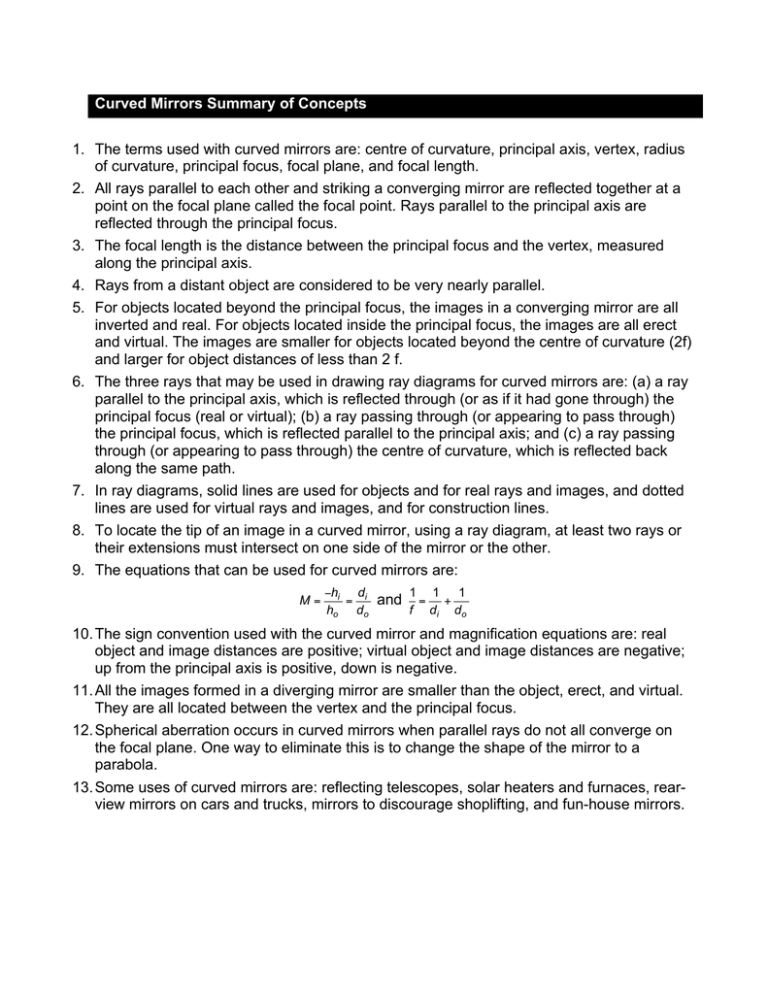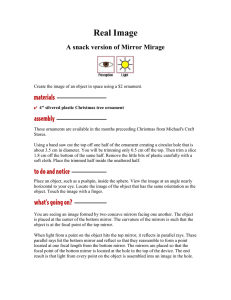8a. CurvedMirrorsSummaryReview 1141KB Apr 30 2010 10:40
advertisement

Curved Mirrors Summary of Concepts 1. The terms used with curved mirrors are: centre of curvature, principal axis, vertex, radius of curvature, principal focus, focal plane, and focal length. 2. All rays parallel to each other and striking a converging mirror are reflected together at a point on the focal plane called the focal point. Rays parallel to the principal axis are reflected through the principal focus. 3. The focal length is the distance between the principal focus and the vertex, measured along the principal axis. 4. Rays from a distant object are considered to be very nearly parallel. 5. For objects located beyond the principal focus, the images in a converging mirror are all inverted and real. For objects located inside the principal focus, the images are all erect and virtual. The images are smaller for objects located beyond the centre of curvature (2f) and larger for object distances of less than 2 f. 6. The three rays that may be used in drawing ray diagrams for curved mirrors are: (a) a ray parallel to the principal axis, which is reflected through (or as if it had gone through) the principal focus (real or virtual); (b) a ray passing through (or appearing to pass through) the principal focus, which is reflected parallel to the principal axis; and (c) a ray passing through (or appearing to pass through) the centre of curvature, which is reflected back along the same path. 7. In ray diagrams, solid lines are used for objects and for real rays and images, and dotted lines are used for virtual rays and images, and for construction lines. 8. To locate the tip of an image in a curved mirror, using a ray diagram, at least two rays or their extensions must intersect on one side of the mirror or the other. 9. The equations that can be used for curved mirrors are: M= −hi di 1 1 1 = and = + ho do f di do 10. The sign convention used with the curved mirror and magnification equations are: real object and image distances are positive; virtual object and image distances are negative; € is positive, down € is negative. up from the principal axis 11. All the images formed in a diverging mirror are smaller than the object, erect, and virtual. They are all located between the vertex and the principal focus. 12. Spherical aberration occurs in curved mirrors when parallel rays do not all converge on the focal plane. One way to eliminate this is to change the shape of the mirror to a parabola. 13. Some uses of curved mirrors are: reflecting telescopes, solar heaters and furnaces, rearview mirrors on cars and trucks, mirrors to discourage shoplifting, and fun-house mirrors. Curved Mirrors Review Questions Discussion 1. A converging mirror reflects light from a distant object, causing it to focus 20 cm from the mirror. What is the radius of curvature of the mirror? 2. You are given a converging mirror, a lighted object, and a white screen. Explain how you would find the centre of curvature. 3. When you look at the sun in a wavy lake, it appears distorted. Why? 4. According to the legend, the Roman fleet at Syracuse was burned when Archimedes focused the sun's rays using a large converging mirror. Was this practical? 5. Diverging mirrors are often used in stores to discourage shoplifting. Why are they useful in this application? 6. You are given some sheets of polished steel and told to design fun-house mirrors with each of the following groups of characteristics. (a) Every dimension of a person standing in front of the mirror is enlarged. (b) Every dimension is reduced. (c) All vertical dimensions are made larger, while horizontal dimensions remain the same (that is, the person appears taller and thinner). (d) The upper features are enlarged vertically and the lower features are reduced vertically, while the horizontal dimensions remain the same (that is, the head appears very long and the legs short). With sketches, indicate how you would bend the metal in each case. 7. Two students are doing the same laboratory investigation using identical converging mirrors with a focal length of 25 cm. Each places a candle in front of the mirror and creates an image three times larger. But when they compare notes, they find their object distances are different. How is this possible? Problems 8. List in your notebook the names of the parts numbered 1 to 5 in this diagram. 9. In each of these diagrams, an object and its image appear. Copy the diagrams into your notebook. Locate the centre of curvature in each case. 10. On each of these diagrams, the images formed by curved mirrors are indicated. Copy the diagrams into your notebook and, using ray diagrams, locate the objects. 11. An object and its image, formed by a converging mirror, are indicated on each of these diagrams. Copy the diagrams into your notebook and, using ray diagrams, locate the principal focus of the mirror. 12. A candle 3 cm high is placed 30 cm from a converging mirror with a focal length of 20 cm. By means of a scale ray diagram, locate the image, and determine its height. State the image's characteristics. 13. Use careful scale drawings to locate the images in each of the following cases. State the characteristics of each image. (a) A converging mirror has a focal length of 20 cm. An object is placed at (i) 10 cm, (ii) 30 cm, and (iii) 40 cm from the vertex of the mirror. (b) A diverging mirror has a focal length of 20 cm. An object is placed (i) 10 cm, and (ii) 30 cm from the vertex of the mirror. 14. A woman looks at herself in a magnifying converging mirror whose focal length is 20 cm. If her face is 10 cm from the mirror, (a) at what distance from the mirror is her image? (b) what is the magnification of her face? 15. A 2.0 cm high candle is placed 15 cm in front of a converging mirror with a focal length of 30 cm. How far "behind" the mirror does the candle appear, and how large is it? 16. A dentist holds a converging mirror with a focal length of 20 mm a distance of 15 mm from a tooth. What is the magnification of a filling in the tooth? 17. A trucker sees the image of a car passing her truck in her diverging rear-view mirror, whose focal length is -60 cm. If the car is 1.5 m high and 6.0 m away, what is the size and location of the image? 18. A spherical, polished metallic ball is used as a diverging mirror (f = -20 cm) over a birdbath. A bird, 25 cm tall, stands 50 cm away from the mirror. What are the size and position of the bird's image? 19. When standing 2.0 m in front of an amusement park mirror, you notice that your image is three times taller. What is the radius of curvature of the mirror? 20. A child looks at his reflection in a spherical mirrored ball 8.0 cm in diameter, and sees that the image of his face is reduced by one-half. How far is his face from the ball? 21. A converging mirror has a focal length of 15 cm. Where would you place an object in order to produce an erect virtual image twice as tall as the object? Answers to selected questions 14. a) –20 cm b) +2 15. -30 cm, 16 cm 16. 4 17. 11 cm, -0.67 m 18. 7.2 cm, -14 cm 19. 6.0 m 20. 2.0 cm 21. d0 = 7.5 cm


